Analysis of Web 3.0: Features, Design Trends, and Personal Reflections
VerifiedAdded on 2022/12/19
|8
|1700
|34
Report
AI Summary
This report provides a comprehensive analysis of Web 3.0, a data-driven and semantic web technology. It explores the key features, including the semantic web, artificial intelligence, 3D graphics, and connectivity, and discusses the advantages of Web 3.0, such as increased data accessibility. The report examines the impact of Web 3.0 on design, highlighting the shift towards minimalist designs and the importance of content over flashy elements. It also presents personal reflections and insights on the future of Web 3.0, emphasizing its potential to revolutionize how users interact with the internet. The report concludes by summarizing the key trends driving the development of Web 3.0 and its potential to transform various aspects of life, including how users search for information online and keep their data secure. The references include research papers and articles that support the arguments presented in the report.
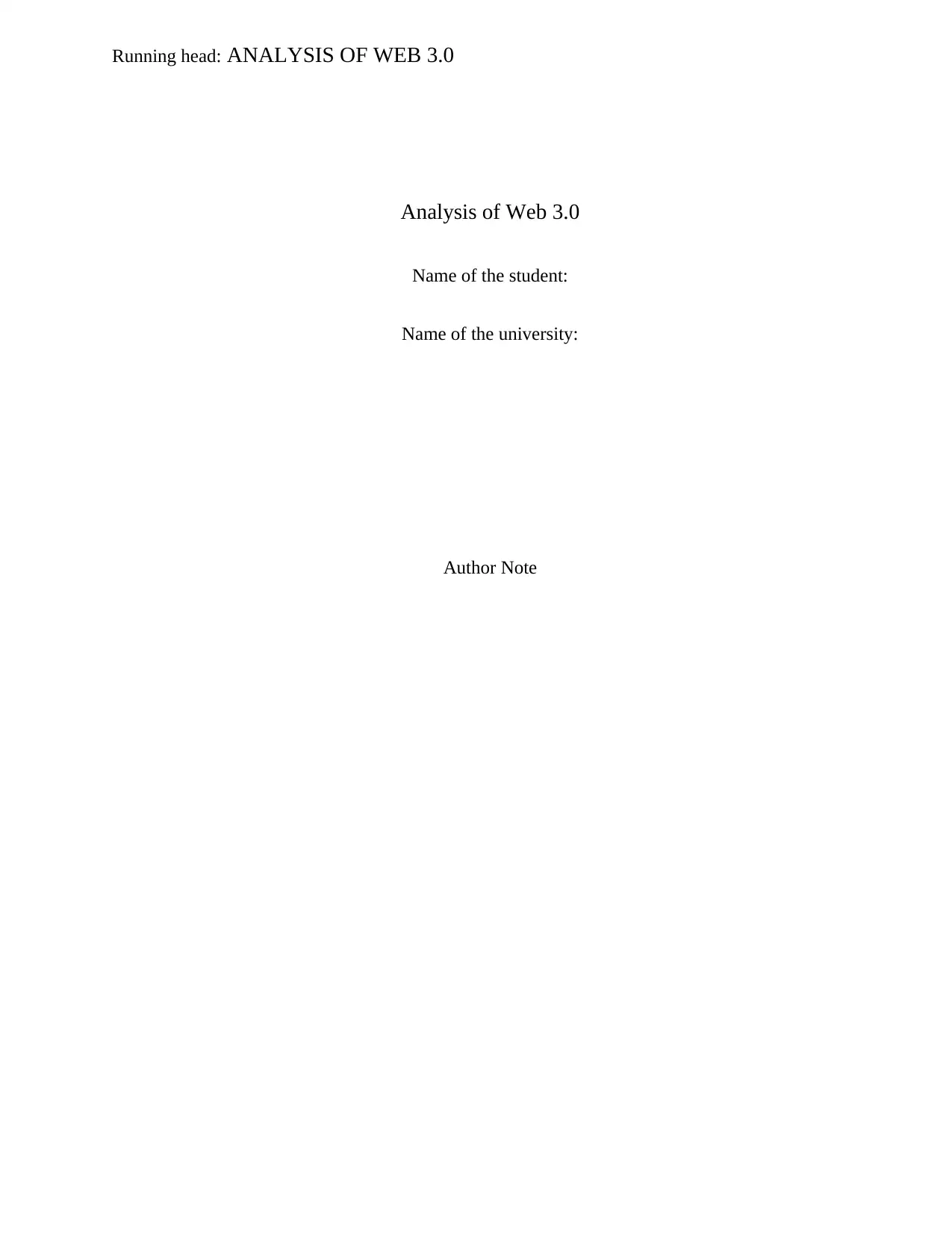
Running head: ANALYSIS OF WEB 3.0
Analysis of Web 3.0
Name of the student:
Name of the university:
Author Note
Analysis of Web 3.0
Name of the student:
Name of the university:
Author Note
Paraphrase This Document
Need a fresh take? Get an instant paraphrase of this document with our AI Paraphraser
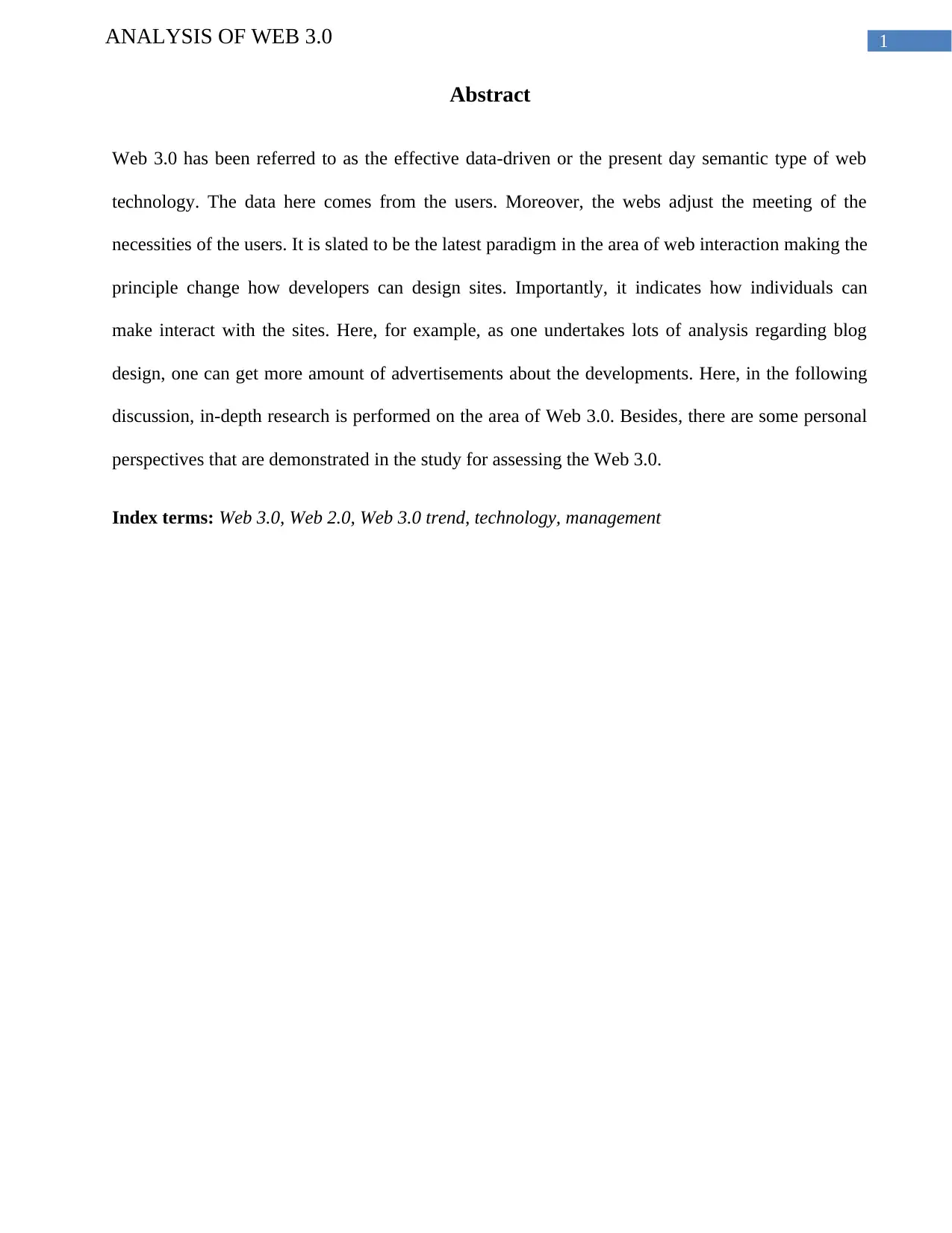
1ANALYSIS OF WEB 3.0
Abstract
Web 3.0 has been referred to as the effective data-driven or the present day semantic type of web
technology. The data here comes from the users. Moreover, the webs adjust the meeting of the
necessities of the users. It is slated to be the latest paradigm in the area of web interaction making the
principle change how developers can design sites. Importantly, it indicates how individuals can
make interact with the sites. Here, for example, as one undertakes lots of analysis regarding blog
design, one can get more amount of advertisements about the developments. Here, in the following
discussion, in-depth research is performed on the area of Web 3.0. Besides, there are some personal
perspectives that are demonstrated in the study for assessing the Web 3.0.
Index terms: Web 3.0, Web 2.0, Web 3.0 trend, technology, management
Abstract
Web 3.0 has been referred to as the effective data-driven or the present day semantic type of web
technology. The data here comes from the users. Moreover, the webs adjust the meeting of the
necessities of the users. It is slated to be the latest paradigm in the area of web interaction making the
principle change how developers can design sites. Importantly, it indicates how individuals can
make interact with the sites. Here, for example, as one undertakes lots of analysis regarding blog
design, one can get more amount of advertisements about the developments. Here, in the following
discussion, in-depth research is performed on the area of Web 3.0. Besides, there are some personal
perspectives that are demonstrated in the study for assessing the Web 3.0.
Index terms: Web 3.0, Web 2.0, Web 3.0 trend, technology, management
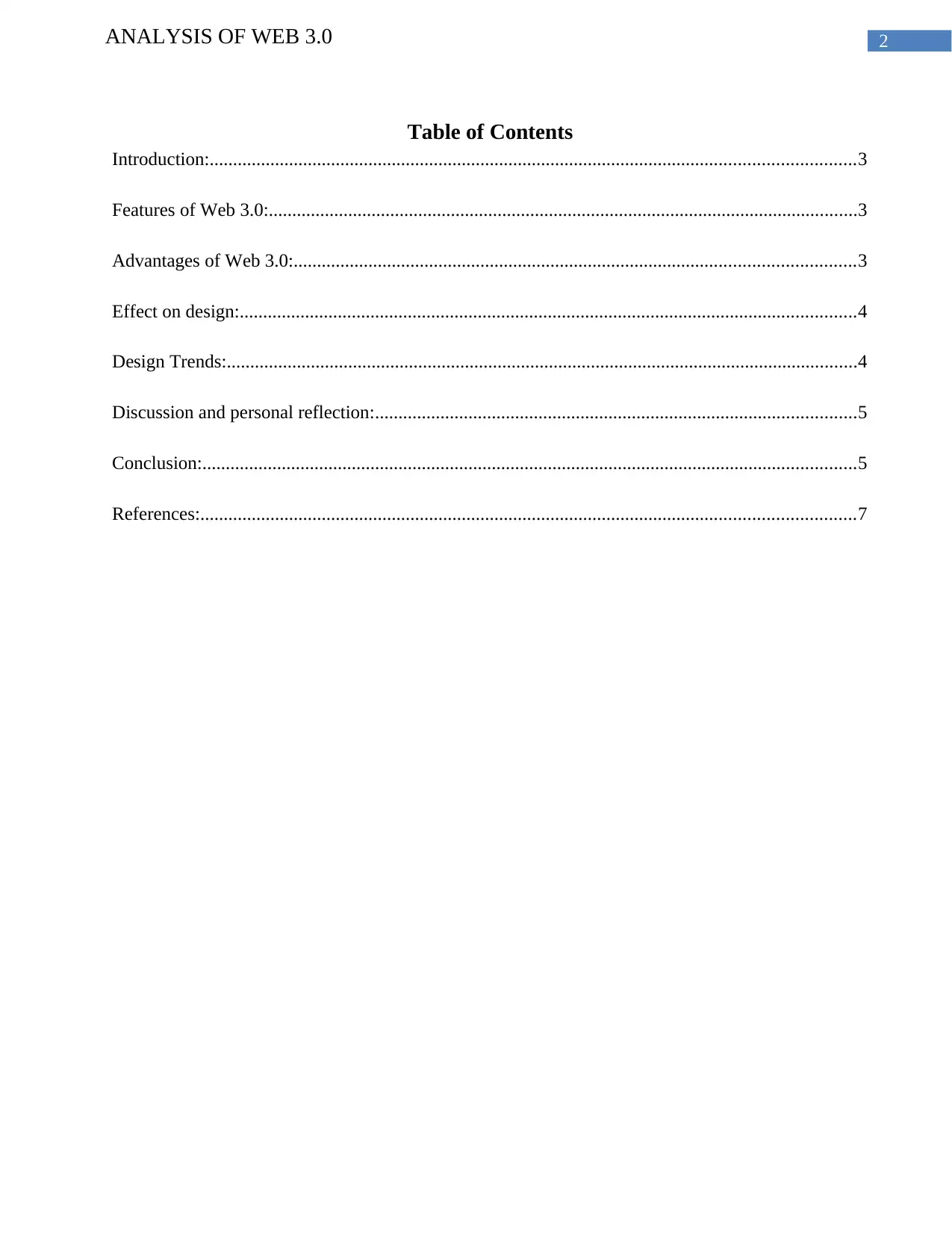
2ANALYSIS OF WEB 3.0
Table of Contents
Introduction:..........................................................................................................................................3
Features of Web 3.0:..............................................................................................................................3
Advantages of Web 3.0:........................................................................................................................3
Effect on design:....................................................................................................................................4
Design Trends:.......................................................................................................................................4
Discussion and personal reflection:.......................................................................................................5
Conclusion:............................................................................................................................................5
References:............................................................................................................................................7
Table of Contents
Introduction:..........................................................................................................................................3
Features of Web 3.0:..............................................................................................................................3
Advantages of Web 3.0:........................................................................................................................3
Effect on design:....................................................................................................................................4
Design Trends:.......................................................................................................................................4
Discussion and personal reflection:.......................................................................................................5
Conclusion:............................................................................................................................................5
References:............................................................................................................................................7
⊘ This is a preview!⊘
Do you want full access?
Subscribe today to unlock all pages.

Trusted by 1+ million students worldwide
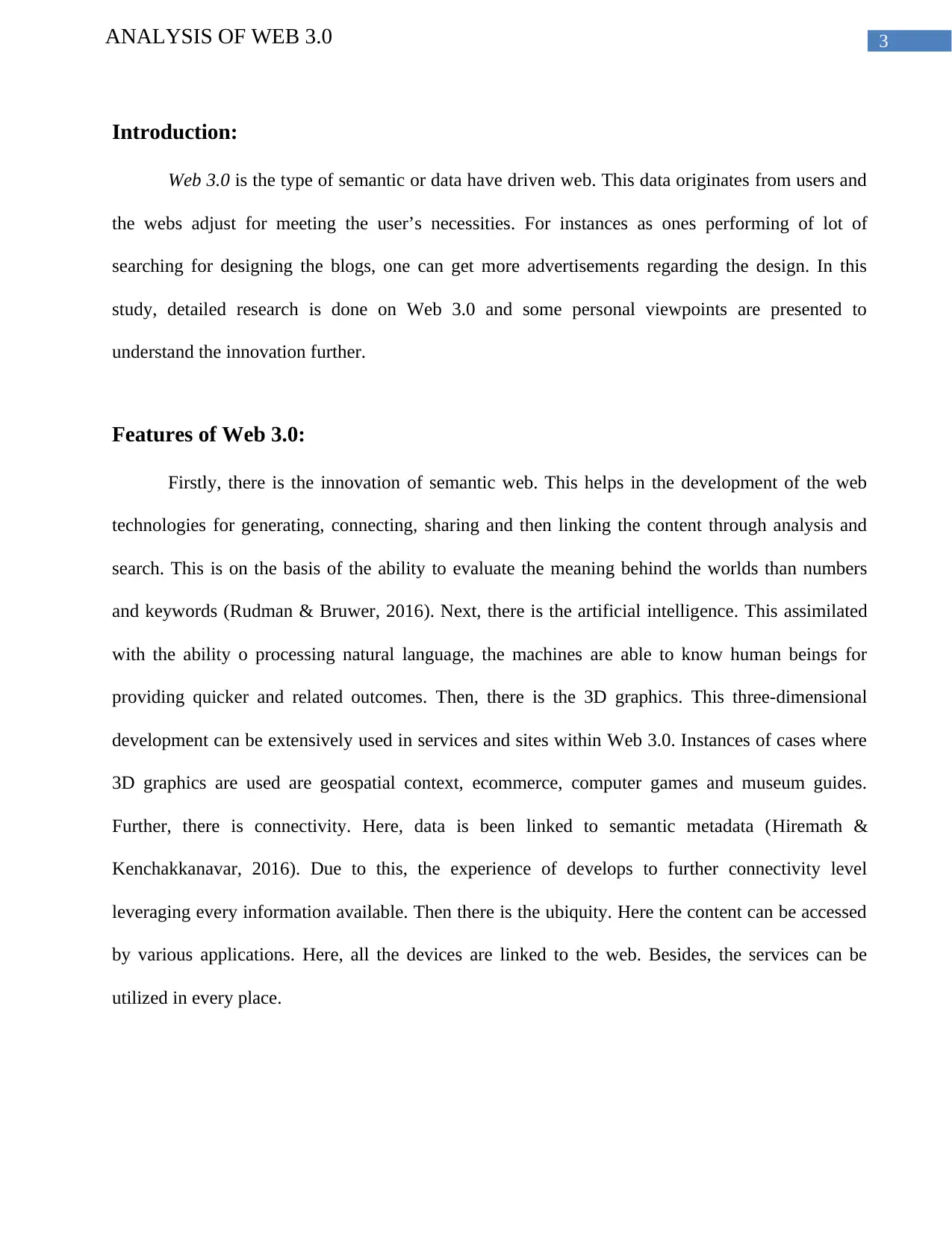
3ANALYSIS OF WEB 3.0
Introduction:
Web 3.0 is the type of semantic or data have driven web. This data originates from users and
the webs adjust for meeting the user’s necessities. For instances as ones performing of lot of
searching for designing the blogs, one can get more advertisements regarding the design. In this
study, detailed research is done on Web 3.0 and some personal viewpoints are presented to
understand the innovation further.
Features of Web 3.0:
Firstly, there is the innovation of semantic web. This helps in the development of the web
technologies for generating, connecting, sharing and then linking the content through analysis and
search. This is on the basis of the ability to evaluate the meaning behind the worlds than numbers
and keywords (Rudman & Bruwer, 2016). Next, there is the artificial intelligence. This assimilated
with the ability o processing natural language, the machines are able to know human beings for
providing quicker and related outcomes. Then, there is the 3D graphics. This three-dimensional
development can be extensively used in services and sites within Web 3.0. Instances of cases where
3D graphics are used are geospatial context, ecommerce, computer games and museum guides.
Further, there is connectivity. Here, data is been linked to semantic metadata (Hiremath &
Kenchakkanavar, 2016). Due to this, the experience of develops to further connectivity level
leveraging every information available. Then there is the ubiquity. Here the content can be accessed
by various applications. Here, all the devices are linked to the web. Besides, the services can be
utilized in every place.
Introduction:
Web 3.0 is the type of semantic or data have driven web. This data originates from users and
the webs adjust for meeting the user’s necessities. For instances as ones performing of lot of
searching for designing the blogs, one can get more advertisements regarding the design. In this
study, detailed research is done on Web 3.0 and some personal viewpoints are presented to
understand the innovation further.
Features of Web 3.0:
Firstly, there is the innovation of semantic web. This helps in the development of the web
technologies for generating, connecting, sharing and then linking the content through analysis and
search. This is on the basis of the ability to evaluate the meaning behind the worlds than numbers
and keywords (Rudman & Bruwer, 2016). Next, there is the artificial intelligence. This assimilated
with the ability o processing natural language, the machines are able to know human beings for
providing quicker and related outcomes. Then, there is the 3D graphics. This three-dimensional
development can be extensively used in services and sites within Web 3.0. Instances of cases where
3D graphics are used are geospatial context, ecommerce, computer games and museum guides.
Further, there is connectivity. Here, data is been linked to semantic metadata (Hiremath &
Kenchakkanavar, 2016). Due to this, the experience of develops to further connectivity level
leveraging every information available. Then there is the ubiquity. Here the content can be accessed
by various applications. Here, all the devices are linked to the web. Besides, the services can be
utilized in every place.
Paraphrase This Document
Need a fresh take? Get an instant paraphrase of this document with our AI Paraphraser
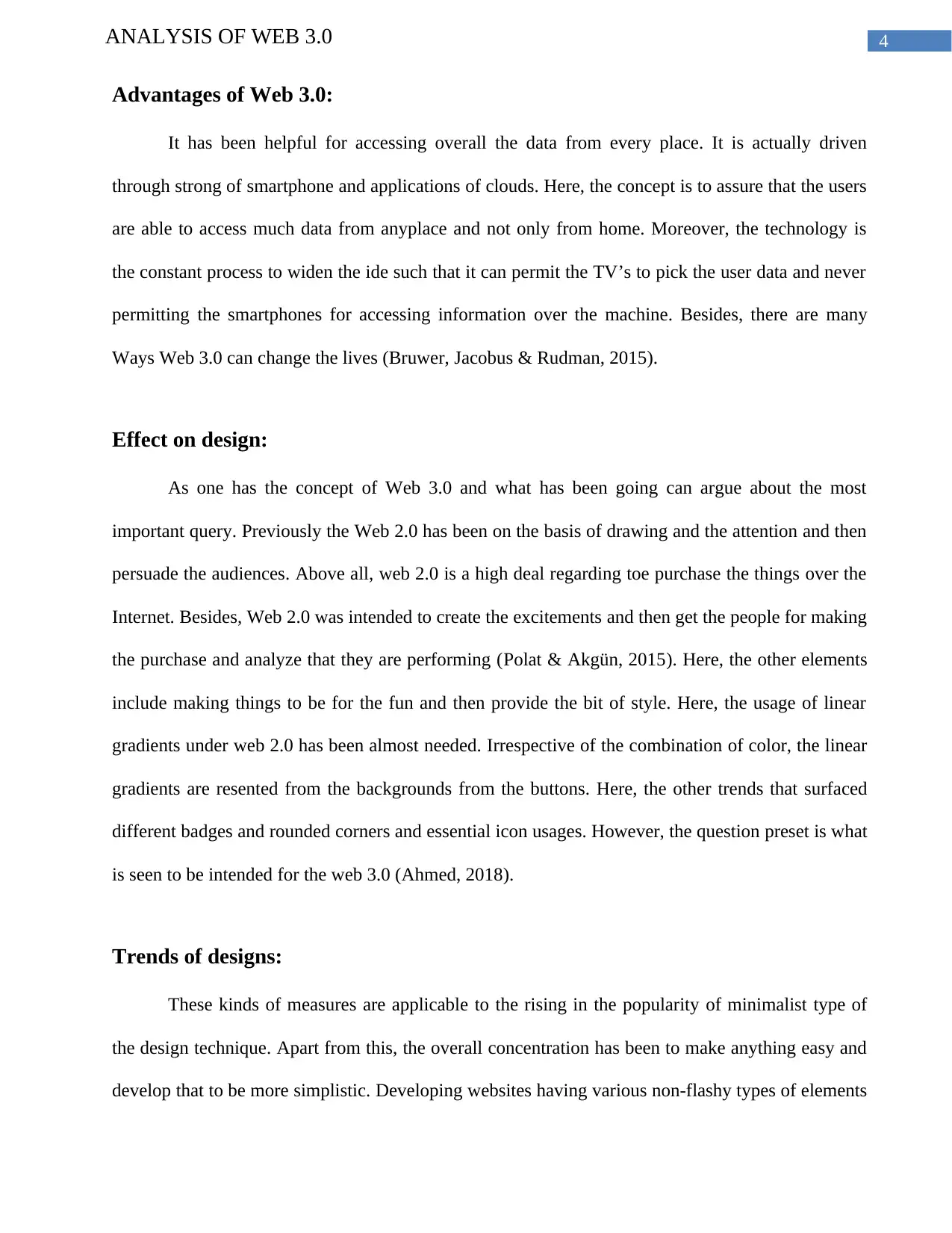
4ANALYSIS OF WEB 3.0
Advantages of Web 3.0:
It has been helpful for accessing overall the data from every place. It is actually driven
through strong of smartphone and applications of clouds. Here, the concept is to assure that the users
are able to access much data from anyplace and not only from home. Moreover, the technology is
the constant process to widen the ide such that it can permit the TV’s to pick the user data and never
permitting the smartphones for accessing information over the machine. Besides, there are many
Ways Web 3.0 can change the lives (Bruwer, Jacobus & Rudman, 2015).
Effect on design:
As one has the concept of Web 3.0 and what has been going can argue about the most
important query. Previously the Web 2.0 has been on the basis of drawing and the attention and then
persuade the audiences. Above all, web 2.0 is a high deal regarding toe purchase the things over the
Internet. Besides, Web 2.0 was intended to create the excitements and then get the people for making
the purchase and analyze that they are performing (Polat & Akgün, 2015). Here, the other elements
include making things to be for the fun and then provide the bit of style. Here, the usage of linear
gradients under web 2.0 has been almost needed. Irrespective of the combination of color, the linear
gradients are resented from the backgrounds from the buttons. Here, the other trends that surfaced
different badges and rounded corners and essential icon usages. However, the question preset is what
is seen to be intended for the web 3.0 (Ahmed, 2018).
Trends of designs:
These kinds of measures are applicable to the rising in the popularity of minimalist type of
the design technique. Apart from this, the overall concentration has been to make anything easy and
develop that to be more simplistic. Developing websites having various non-flashy types of elements
Advantages of Web 3.0:
It has been helpful for accessing overall the data from every place. It is actually driven
through strong of smartphone and applications of clouds. Here, the concept is to assure that the users
are able to access much data from anyplace and not only from home. Moreover, the technology is
the constant process to widen the ide such that it can permit the TV’s to pick the user data and never
permitting the smartphones for accessing information over the machine. Besides, there are many
Ways Web 3.0 can change the lives (Bruwer, Jacobus & Rudman, 2015).
Effect on design:
As one has the concept of Web 3.0 and what has been going can argue about the most
important query. Previously the Web 2.0 has been on the basis of drawing and the attention and then
persuade the audiences. Above all, web 2.0 is a high deal regarding toe purchase the things over the
Internet. Besides, Web 2.0 was intended to create the excitements and then get the people for making
the purchase and analyze that they are performing (Polat & Akgün, 2015). Here, the other elements
include making things to be for the fun and then provide the bit of style. Here, the usage of linear
gradients under web 2.0 has been almost needed. Irrespective of the combination of color, the linear
gradients are resented from the backgrounds from the buttons. Here, the other trends that surfaced
different badges and rounded corners and essential icon usages. However, the question preset is what
is seen to be intended for the web 3.0 (Ahmed, 2018).
Trends of designs:
These kinds of measures are applicable to the rising in the popularity of minimalist type of
the design technique. Apart from this, the overall concentration has been to make anything easy and
develop that to be more simplistic. Developing websites having various non-flashy types of elements
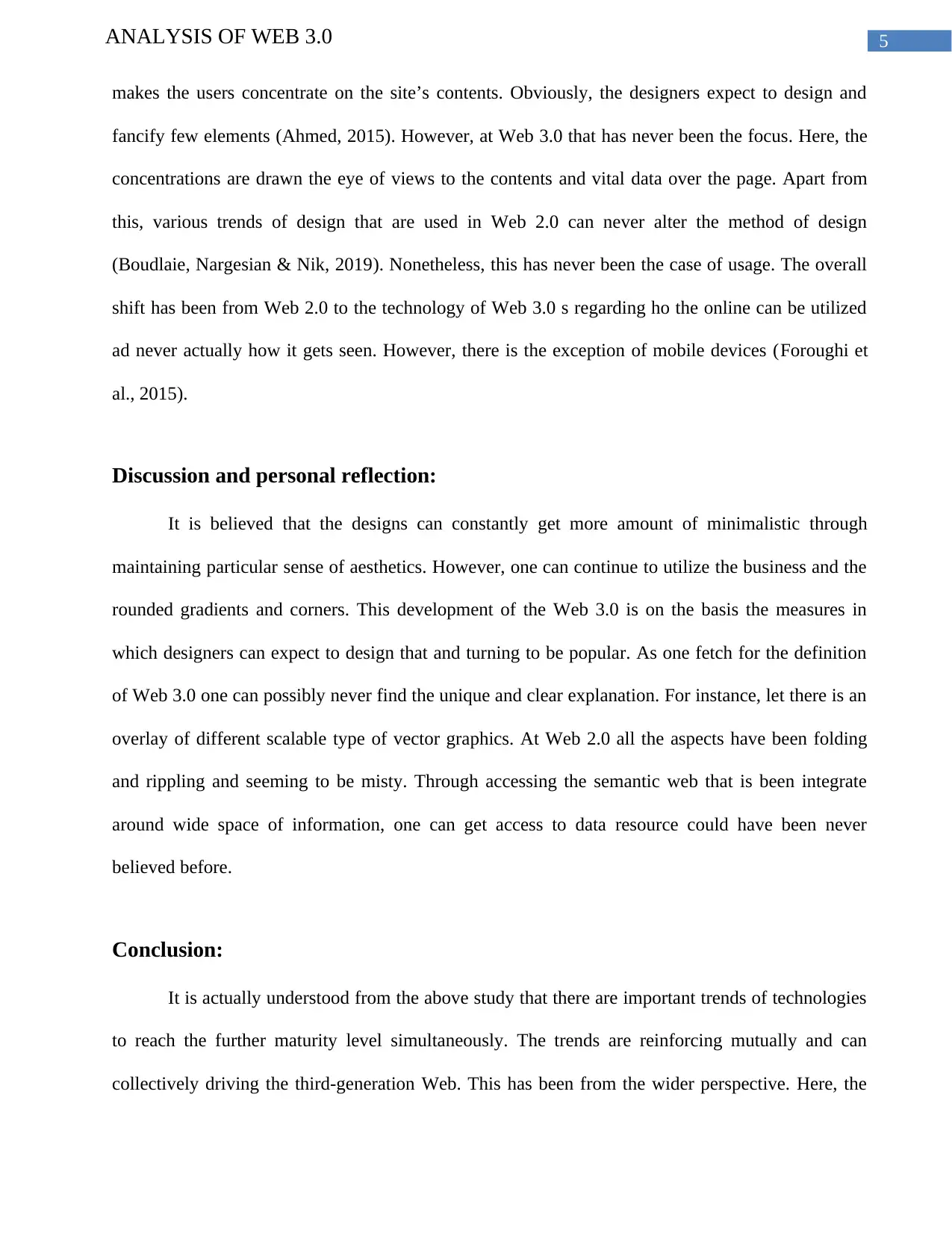
5ANALYSIS OF WEB 3.0
makes the users concentrate on the site’s contents. Obviously, the designers expect to design and
fancify few elements (Ahmed, 2015). However, at Web 3.0 that has never been the focus. Here, the
concentrations are drawn the eye of views to the contents and vital data over the page. Apart from
this, various trends of design that are used in Web 2.0 can never alter the method of design
(Boudlaie, Nargesian & Nik, 2019). Nonetheless, this has never been the case of usage. The overall
shift has been from Web 2.0 to the technology of Web 3.0 s regarding ho the online can be utilized
ad never actually how it gets seen. However, there is the exception of mobile devices (Foroughi et
al., 2015).
Discussion and personal reflection:
It is believed that the designs can constantly get more amount of minimalistic through
maintaining particular sense of aesthetics. However, one can continue to utilize the business and the
rounded gradients and corners. This development of the Web 3.0 is on the basis the measures in
which designers can expect to design that and turning to be popular. As one fetch for the definition
of Web 3.0 one can possibly never find the unique and clear explanation. For instance, let there is an
overlay of different scalable type of vector graphics. At Web 2.0 all the aspects have been folding
and rippling and seeming to be misty. Through accessing the semantic web that is been integrate
around wide space of information, one can get access to data resource could have been never
believed before.
Conclusion:
It is actually understood from the above study that there are important trends of technologies
to reach the further maturity level simultaneously. The trends are reinforcing mutually and can
collectively driving the third-generation Web. This has been from the wider perspective. Here, the
makes the users concentrate on the site’s contents. Obviously, the designers expect to design and
fancify few elements (Ahmed, 2015). However, at Web 3.0 that has never been the focus. Here, the
concentrations are drawn the eye of views to the contents and vital data over the page. Apart from
this, various trends of design that are used in Web 2.0 can never alter the method of design
(Boudlaie, Nargesian & Nik, 2019). Nonetheless, this has never been the case of usage. The overall
shift has been from Web 2.0 to the technology of Web 3.0 s regarding ho the online can be utilized
ad never actually how it gets seen. However, there is the exception of mobile devices (Foroughi et
al., 2015).
Discussion and personal reflection:
It is believed that the designs can constantly get more amount of minimalistic through
maintaining particular sense of aesthetics. However, one can continue to utilize the business and the
rounded gradients and corners. This development of the Web 3.0 is on the basis the measures in
which designers can expect to design that and turning to be popular. As one fetch for the definition
of Web 3.0 one can possibly never find the unique and clear explanation. For instance, let there is an
overlay of different scalable type of vector graphics. At Web 2.0 all the aspects have been folding
and rippling and seeming to be misty. Through accessing the semantic web that is been integrate
around wide space of information, one can get access to data resource could have been never
believed before.
Conclusion:
It is actually understood from the above study that there are important trends of technologies
to reach the further maturity level simultaneously. The trends are reinforcing mutually and can
collectively driving the third-generation Web. This has been from the wider perspective. Here, the
⊘ This is a preview!⊘
Do you want full access?
Subscribe today to unlock all pages.

Trusted by 1+ million students worldwide
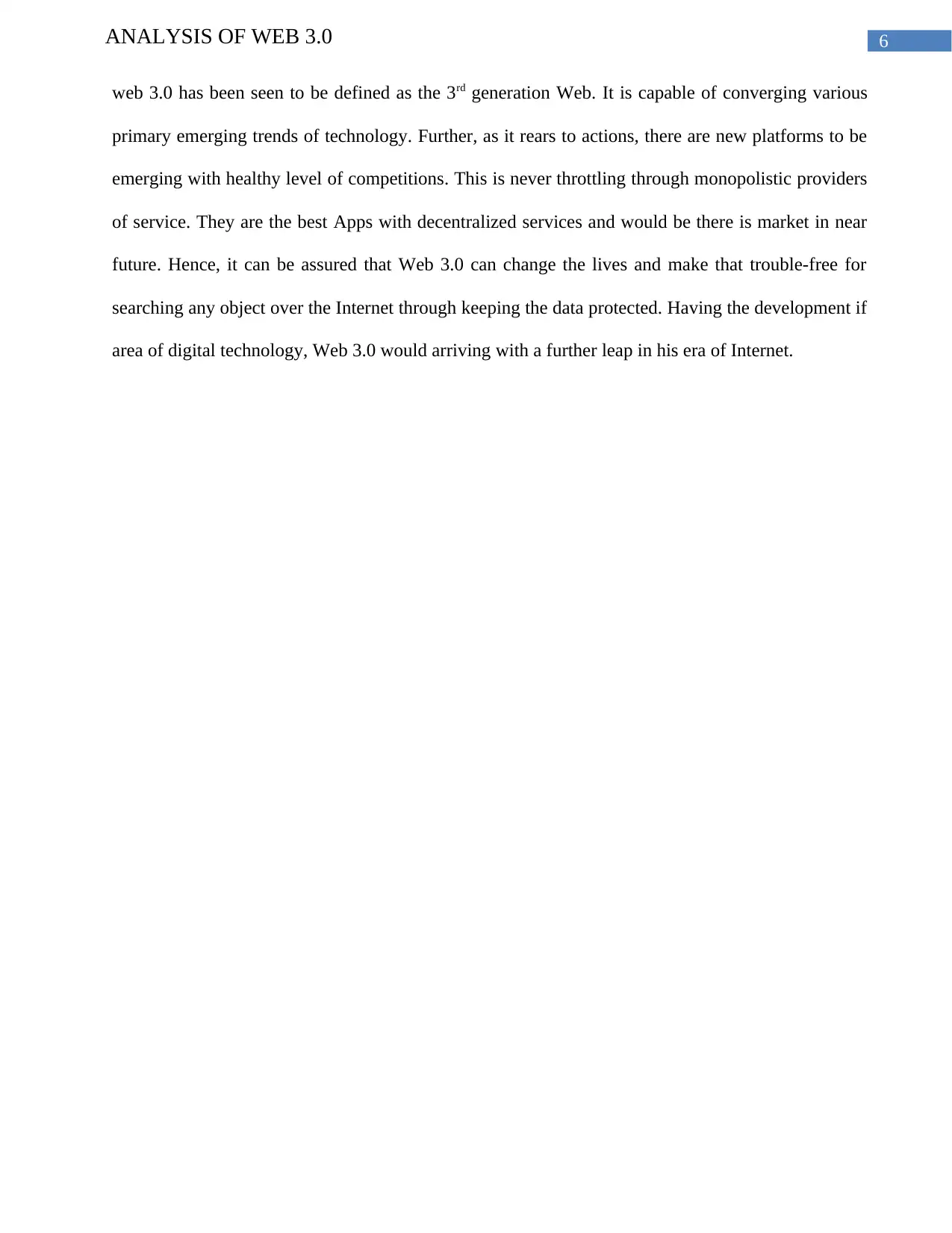
6ANALYSIS OF WEB 3.0
web 3.0 has been seen to be defined as the 3rd generation Web. It is capable of converging various
primary emerging trends of technology. Further, as it rears to actions, there are new platforms to be
emerging with healthy level of competitions. This is never throttling through monopolistic providers
of service. They are the best Apps with decentralized services and would be there is market in near
future. Hence, it can be assured that Web 3.0 can change the lives and make that trouble-free for
searching any object over the Internet through keeping the data protected. Having the development if
area of digital technology, Web 3.0 would arriving with a further leap in his era of Internet.
web 3.0 has been seen to be defined as the 3rd generation Web. It is capable of converging various
primary emerging trends of technology. Further, as it rears to actions, there are new platforms to be
emerging with healthy level of competitions. This is never throttling through monopolistic providers
of service. They are the best Apps with decentralized services and would be there is market in near
future. Hence, it can be assured that Web 3.0 can change the lives and make that trouble-free for
searching any object over the Internet through keeping the data protected. Having the development if
area of digital technology, Web 3.0 would arriving with a further leap in his era of Internet.
Paraphrase This Document
Need a fresh take? Get an instant paraphrase of this document with our AI Paraphraser
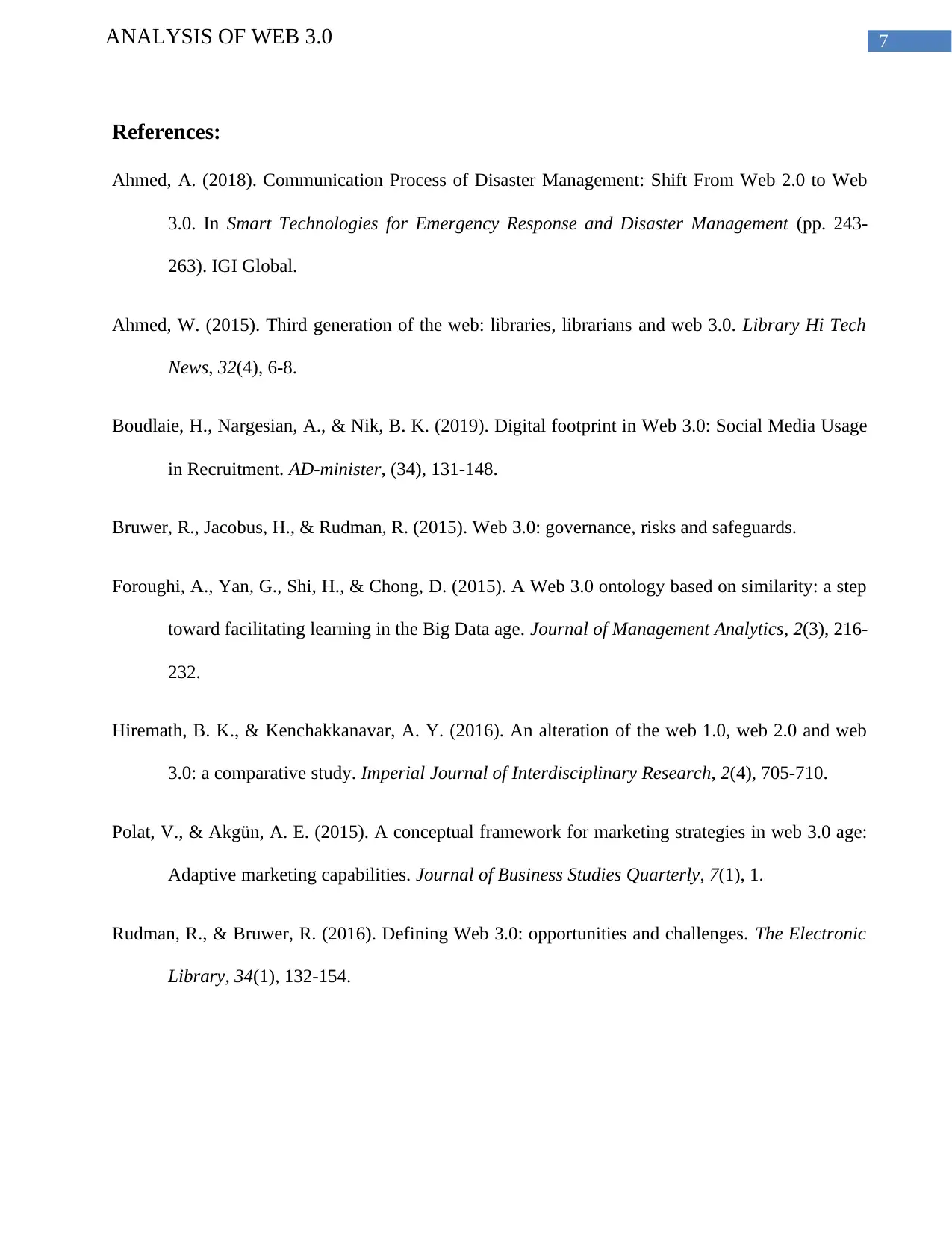
7ANALYSIS OF WEB 3.0
References:
Ahmed, A. (2018). Communication Process of Disaster Management: Shift From Web 2.0 to Web
3.0. In Smart Technologies for Emergency Response and Disaster Management (pp. 243-
263). IGI Global.
Ahmed, W. (2015). Third generation of the web: libraries, librarians and web 3.0. Library Hi Tech
News, 32(4), 6-8.
Boudlaie, H., Nargesian, A., & Nik, B. K. (2019). Digital footprint in Web 3.0: Social Media Usage
in Recruitment. AD-minister, (34), 131-148.
Bruwer, R., Jacobus, H., & Rudman, R. (2015). Web 3.0: governance, risks and safeguards.
Foroughi, A., Yan, G., Shi, H., & Chong, D. (2015). A Web 3.0 ontology based on similarity: a step
toward facilitating learning in the Big Data age. Journal of Management Analytics, 2(3), 216-
232.
Hiremath, B. K., & Kenchakkanavar, A. Y. (2016). An alteration of the web 1.0, web 2.0 and web
3.0: a comparative study. Imperial Journal of Interdisciplinary Research, 2(4), 705-710.
Polat, V., & Akgün, A. E. (2015). A conceptual framework for marketing strategies in web 3.0 age:
Adaptive marketing capabilities. Journal of Business Studies Quarterly, 7(1), 1.
Rudman, R., & Bruwer, R. (2016). Defining Web 3.0: opportunities and challenges. The Electronic
Library, 34(1), 132-154.
References:
Ahmed, A. (2018). Communication Process of Disaster Management: Shift From Web 2.0 to Web
3.0. In Smart Technologies for Emergency Response and Disaster Management (pp. 243-
263). IGI Global.
Ahmed, W. (2015). Third generation of the web: libraries, librarians and web 3.0. Library Hi Tech
News, 32(4), 6-8.
Boudlaie, H., Nargesian, A., & Nik, B. K. (2019). Digital footprint in Web 3.0: Social Media Usage
in Recruitment. AD-minister, (34), 131-148.
Bruwer, R., Jacobus, H., & Rudman, R. (2015). Web 3.0: governance, risks and safeguards.
Foroughi, A., Yan, G., Shi, H., & Chong, D. (2015). A Web 3.0 ontology based on similarity: a step
toward facilitating learning in the Big Data age. Journal of Management Analytics, 2(3), 216-
232.
Hiremath, B. K., & Kenchakkanavar, A. Y. (2016). An alteration of the web 1.0, web 2.0 and web
3.0: a comparative study. Imperial Journal of Interdisciplinary Research, 2(4), 705-710.
Polat, V., & Akgün, A. E. (2015). A conceptual framework for marketing strategies in web 3.0 age:
Adaptive marketing capabilities. Journal of Business Studies Quarterly, 7(1), 1.
Rudman, R., & Bruwer, R. (2016). Defining Web 3.0: opportunities and challenges. The Electronic
Library, 34(1), 132-154.
1 out of 8
Related Documents
Your All-in-One AI-Powered Toolkit for Academic Success.
+13062052269
info@desklib.com
Available 24*7 on WhatsApp / Email
![[object Object]](/_next/static/media/star-bottom.7253800d.svg)
Unlock your academic potential
Copyright © 2020–2025 A2Z Services. All Rights Reserved. Developed and managed by ZUCOL.




